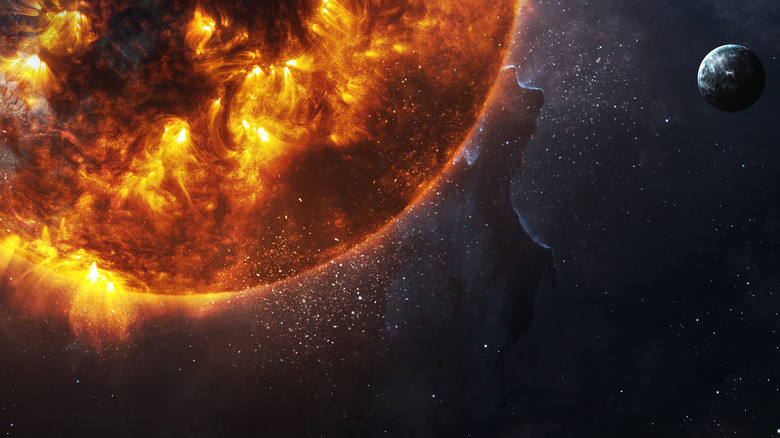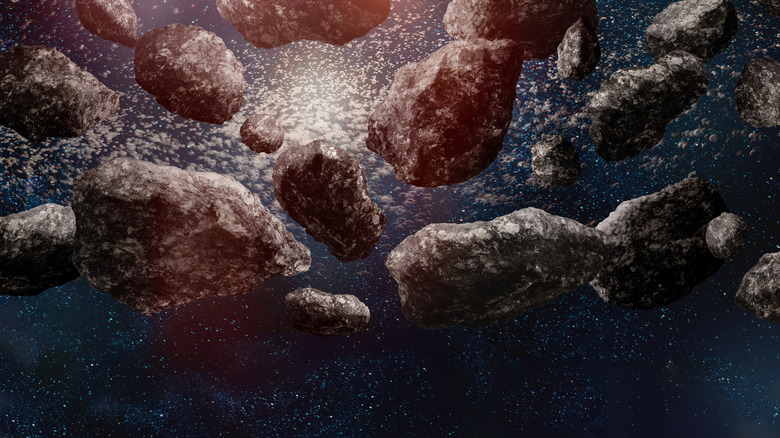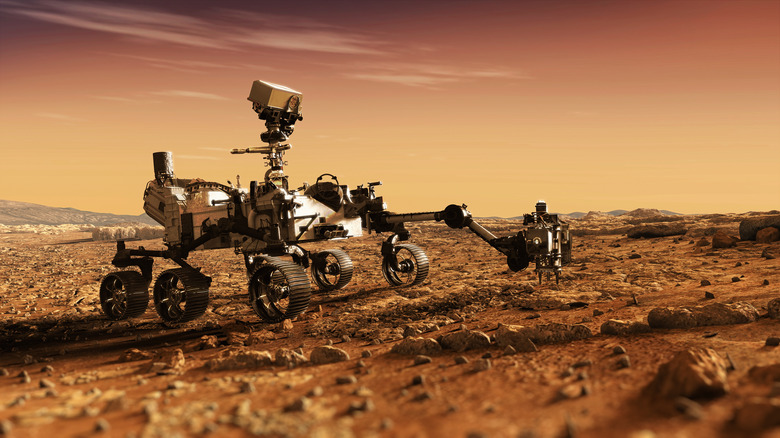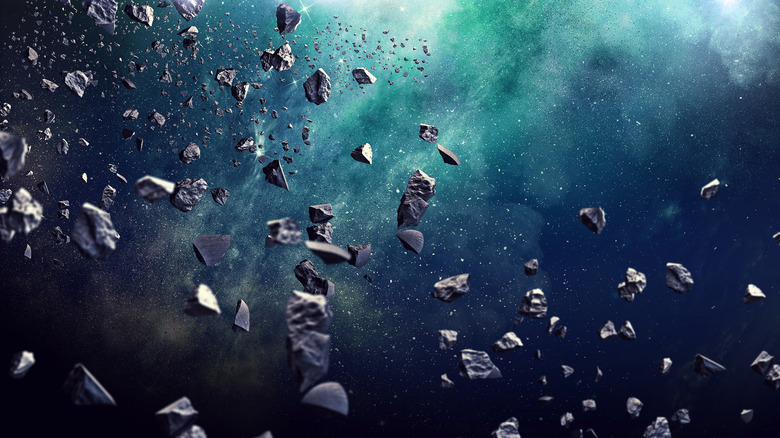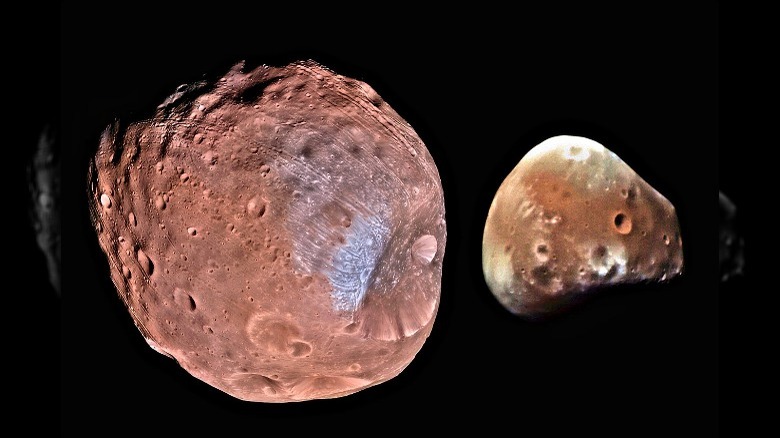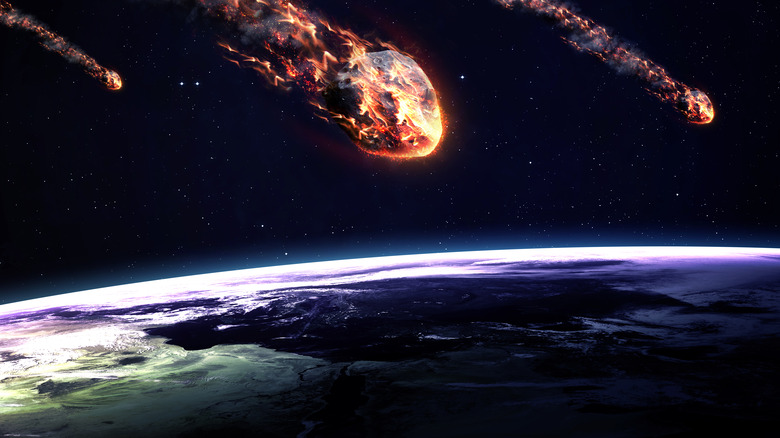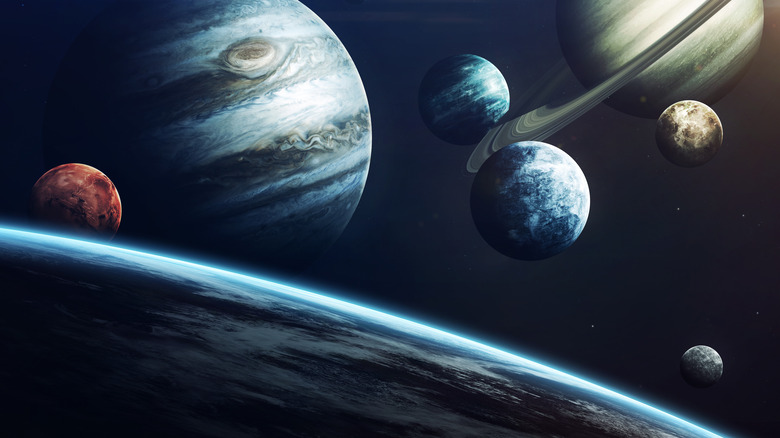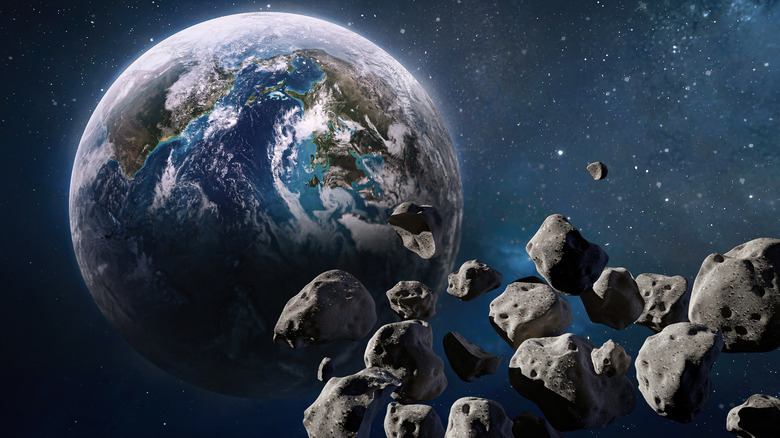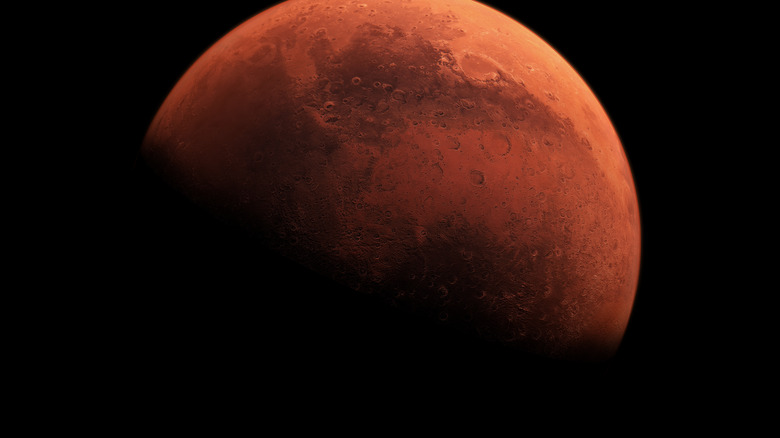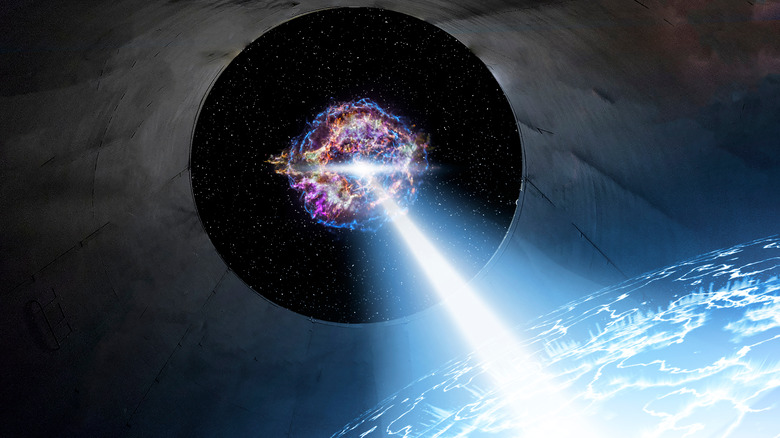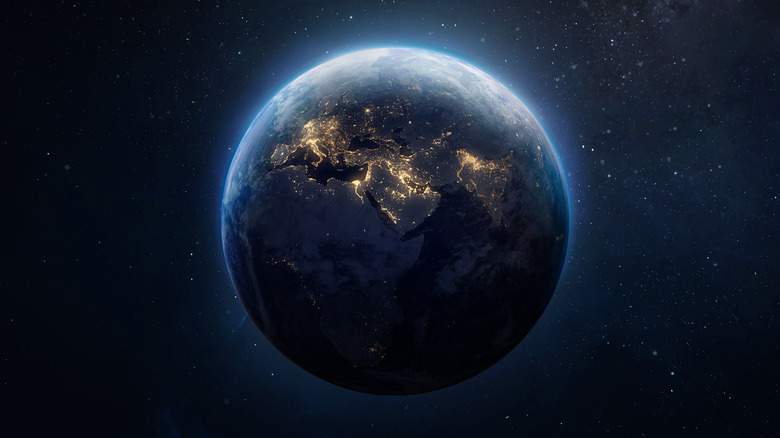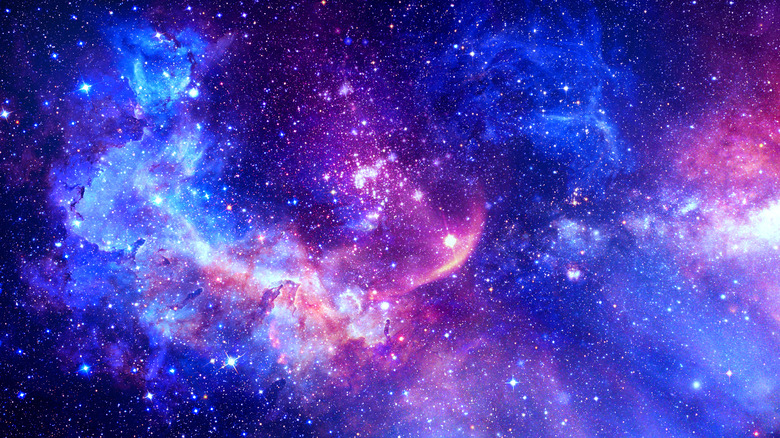Here's What Would Happen If Mars Suddenly Exploded
Have you ever had a day where you just really wanted to go full sci-fi supervillain? Maybe you start brainstorming exactly how you would show off your power to the entire universe, and maybe you landed on the destruction of worlds. "Death, the destroyer of worlds" does have a ring to it after all, although in this case, you'd be working with something even more massive than a nuclear bomb. Or maybe the question of a planet exploding is just an academic one you had while sitting on the couch, because space is cool and weird and wild. That also makes enough sense. After all, space is very cool.
Unfortunately, there's not a lot of research out there explicitly looking into what would happen if Mars just up and exploded. That sort of thing isn't necessarily at the forefront of research at the moment. Could it be, someday? Anything can happen, but maybe it'd be best not to hold your breath, to be frank.
Regardless, we always have speculation and research that is actually out there, which could potentially be relevant to our particular question here. So here is a fun thought experiment involving the hypothetical situation of Mars blowing up.
In the past, people might have predicted a new asteroid belt would form
Honestly, this theory does make a decent amount of sense on the surface. After all, think about it. If Mars exploded, there would be Martian debris just left floating around in space. And, hey, given that all that debris is there in Mars' orbit, why wouldn't they continue circling around the Sun? A bunch of space rocks orbiting around the Sun — sounds a lot like the asteroid belt, right?
That's not completely baseless speculation. Guide to the Universe says that the exact same theory existed to explain the presence of the actual asteroid belt. In the past, it was believed that another planet existed between Mars and Jupiter, but upon discovering that the area was filled with asteroids, that theory shifted. Instead, those asteroids were thought to be the debris from a long-dead planet, called Phaeton. More recent findings even seem to support such a theory, with researchers discovering diamonds in a couple of meteorites, implying that they may have come from a destroyed planet — diamonds need a lot of pressure, after all (via Live Science).
That said, though, there was never any sort of consensus as to what destroyed Phaeton, and in the years since, that theory about the formation of the asteroid belt has been largely discarded. Now, it seems more likely that it's the remains of material from the early solar system which was never able to form a planet in the first place
Say goodbye to Mars exploration
While this might not seem like something we'd be worrying about if Mars suddenly blew up, the loss of our most likely next stop in the solar system would be a blow to science.
As National Geographic says, humans have just long been fascinated by Mars, even before we really knew anything about it (it looks like a red star in the sky! That's cool!). And ever since we've gotten a closer look at the surface, the red planet has only raised more questions. Are those platforms actually signs of alien life? Well, they're just natural formations, but are there signs of long-dead oceans and rivers? Was there water on the surface? In that case, was there life, and could life evolve there again?
And the amount of research put in all over the globe backs up that curiosity. Space.com goes through all that research, from the U.S. and U.S.S.R. space programs back in the 1960s returning the first pictures of the surface, to more recent years, with more space programs — from China, Japan, India, and Europe — entering the scene. And, as of writing, there are all the ongoing missions, including those of NASA's Curiosity and Perseverance rovers (may Opportunity rest in peace). Then, of course there's that dream of putting a human colony on Mars. Seeing all that research and determined curiosity go to waste is just kind of sad to think of.
Local asteroids would never be the same
If you picture the asteroid belt, what do you see? Probably a dark and expansive void filled with giant, gray boulders, all dotted with ridges and craters. But if you want to shake up that image a little, did you know that, sometimes, asteroids are kind of red colored?
Red, as in the Red Planet? As in Mars? Yes! Or, well, kind of. They aren't red because they come from Mars, but because they pass near it. According to MIT News, many asteroids look redder than meteorites (asteroids that fall to Earth) and here's the reason: gravity. See, asteroids orbit around the Sun just like the planets do, but sometimes their orbits intersect planetary orbits. If they get close enough to a planet, then that planet's gravity can pull on the surface of the asteroid, causing a mini earthquake (or... asteroid-quake?) That interaction shifts all the rocks in the asteroid, exposing fresh material underneath. That new material is redder, marking the asteroid as "refreshed."
For a while, researchers assumed that Earth was doing most of the refreshing, but later realized that Mars was refreshing at least some of those asteroids. Being smaller than Earth, Mars would need asteroids to pass much closer to have the same effect, but it being right next to the Asteroid Belt mostly takes care of that. Of course, if Mars wasn't around anymore, then some of those asteroids just wouldn't be refreshed again.
Some planets could get new accessories
Funnily enough, Mars itself is the proof of why other planets might get an upgrade if Mars, you know, exploded. The reason for that has to do with Mars' two moons, Phobos and Deimos, which, if you look at them, don't really look like Earth's moon. They have really irregular shapes — not exactly what you'd call spherical — and look more like asteroids. And that's because they might have been asteroids all along (via Space.com). They aren't the only ones, though. The outer planets also have asteroid-like moons, and Saturn's rings are technically just a bunch of smaller asteroids.
The working theory is that these moons were once asteroids travelling in their own orbits, independent from the planets. But at some point, probably during the early days of the solar system, some asteroids approached the planets with just the right speed and direction for the planets' gravity to grab a hold of them, bringing them into orbit. There's a bunch of math backing up this particular mechanism in "Origin of Martian Moons from Binary Asteroid Dissociation," but that's the gist of how natural asteroid capture works.
As for where blowing up Mars comes in, well, the event would put out a bunch of asteroids, flung in different directions and at different speeds. If the right conditions are met for a planet to capture an asteroid, there you go. That's a new moon.
Debris could (maybe) hit Earth
If an entire planet exploded, it's easy to picture the destruction that would follow: fiery bits of rock thrown out in every direction, massive chunks hurtling through space at Mar's nearest neighbor, Earth. That concern isn't entirely unwarranted. The National Radio Astronomy Observatory answered a similar question about the effects of Venus exploding, mentioning that, technically, the chance of meteors hitting Earth might increase. After all, there would just be more asteroids floating around from the explosion.
How dangerous would that really be? According to JPL, at least recently, Earth has been able to deal with meteors. The atmosphere burns up thousands of grain-sized meteors daily, and even when larger pieces manage to make it all the way to the ground, they're pretty likely to land somewhere safe — uninhabited areas or the middle of the ocean. Plus, large asteroids are usually less likely to cross Earth's path.
Now, to bring it back to Mars, there are a couple other things to consider. For one, Mars is about twice as far from Earth as Venus is (via The Planets), and is considerably smaller than Venus (via NASA). Less material and coming from further away — the chances of a dangerous impact probably drop down. So at the end of the day, yes, debris could barrel toward Earth, but would it be dangerous? Impossible to know, but we might be fine.
The orbits of the planets could change drastically
When it comes to space, you've got to talk about gravity, because that's a decently important governing force of what's happening out in the cosmos. When you're talking about the scale of the solar system, it's mostly the Sun running the show, but when you get down into the details, all of the planets are technically affecting each other via gravity as well.
So when it comes to the hypothetical of Mars no longer existing as a planet post explosion, is there a change in gravity? And what sort of change? Well, according to Scientific American, conventional wisdom says, not much. The Sun is just way too powerful in this regard for Mars' gravity to really do much. But upon running a simulation where Mars and Earth switched places (not Mars exploding, but still a seemingly trivial change), things weren't that simple. Mars' new orbit shifted, occasionally dipping in closer to the Sun than Venus, and Mercury's orbit was completely destabilized, bouncing back and forth. In another simulation where Mercury was just ignored (common practice, apparently, since Mercury is just so tiny), Mars was flung out of the solar system entirely.
Basically, here's the point: some theories say that the solar system lives on the edge of chaos, just barely, perfectly balanced. Making one change — switching two planets, or maybe blowing one up — could seriously upset that balance and throw the entire solar system into complete and utter chaos.
Earth might actually be just a little safer
After a planet explodes, the last thing you'd probably expect would be for Earth to actually be safer in the long run. Right? "Explosion" and "safe" aren't the words you'd expect to see together. But it's actually sort of true here, and the reason for that is the asteroid belt. A bunch of asteroids live in the area between Mars and Jupiter, floating around and orbiting the Sun, but, as explained by the ESA, those orbits can be disrupted. Sometimes, that disruption comes from asteroids running into each other, and sometimes it comes from Jupiter's massive gravity giving asteroids a little nudge. Ultimately, these asteroids get knocked out of their orbits, and that's where the problem starts.
Mars actually plays a part at that point, according to ScienceABC. When an asteroid is flung out of its orbit, it can also get pretty close to Mars. If that's the case, Mars' gravity gets involved and can actually slingshot the asteroid even further toward Earth. Granted, that's no guarantee the asteroid would necessarily hit Earth — it could just as easily pass by harmlessly — but it does pose a potential problem.
So if Mars exploded, it would be, effectively, taken out of the equation (at least, that would be the case in the long term). Without it there, you wouldn't get that slingshot effect; Mars can't fling asteroids in our direction if it doesn't exist.
Mars could reform (sort of)
So, to specify: no, if Mars exploded, it wouldn't just miraculously blip back into existence, as if nothing had happened. That's not the point here, because if an exploded planet really did just spontaneously reform, then we'd seriously need to question our understanding of reality.
Physics Today talks about this particular hypothetical of blowing up a planet in general. It already would take a lot of energy to explode a planet, in the sense that you somehow manage to blow it into tiny little bits. But how fast are those pieces moving away? That ends up being a pretty important question, because if all of those pieces accelerate away at escape velocity (the speed something needs to escape the planet's gravity) then, yeah, the planet will just be decimated. But if the pieces aren't all accelerating away quite fast enough, then that means gravity is still going to have a say in what happens.
It's like when you toss a ball in the air; it accelerates upward, then slows down and falls due to gravity. That's what could happen in this hypothetical — planet pieces would fly up and out, then the gravity acting between all of them would pull them back down and together. You'd get the planet back, though it wouldn't be quite the same. It'd just resemble something closer to a floating sphere of gravel rather than a solid rock, but from far enough distances, it would still look like a planet, more or less.
There might be way bigger problems
Let's get one thing straight first: planets don't just explode for no reason. After all, the planets we know and love have survived perfectly well until now. You'd probably have to somehow throw a ton of energy at the planet from outside sources to force it to explode (so, you know, basically the Death Star).
But how much energy would it take? Luckily, Science Alert explained how the math works. Planets are held together by gravity, and you can simulate an explosion by imagining tiny pieces of the planet getting flung out one by one, and fast enough to escape said gravity. With a little bit of calculus, you get your answer: 2.25x10^32 joules of energy could destroy Earth. Space.com helpfully adds how that much energy can be collected. You could cover the entire Earth in solar panels... and wait for 18 million years.
But, alright, Mars isn't as big as Earth, so it should take less energy to blow it up. Running through the math there, you get in the realm of 10^30 joules (5x10^30, to be more accurate). Going with the same solar panel method, you'd need around 400,000 years to collect that. Sure, that's not 18 million years, but it's still a long time, and, frankly, if someone managed to harness that much energy, then the explosion of Mars probably wouldn't be the most pressing issue. Potential cosmic destruction via real-life Death Star might be a little more concerning.
Or maybe nothing would really happen at all
To be entirely honest, it's probably most likely that Mars exploding wouldn't change anything at all. At least, it's the case for the fun stuff: wacky gravity effects and apocalyptic asteroid strikes.
Science ABC says bluntly that, for Earth, if any of the planets disappeared, there probably wouldn't be much of a gravitational change. Most of the inner planets are just too small to have much effect, and while an outer planet disappearing would likely affect the other outer planets (they're really big and have massive gravitational fields), Earth is just too far away. Sciencing supports that with numbers; the Moon actually pulls on Earth the most, followed by the Sun. Everything else is leagues behind. Granted, Scientific American says that conventional wisdom might be wrong, and even a tiny change could completely throw the solar system out of balance, but it's hard to know for sure. (Plus, simulations are sort of finicky).
And when it comes to asteroids, it's a similar story. Per JPL, the probability of a massive collision is tiny; an asteroid would have to be on the perfect trajectory at the perfect speed to actually hit Earth, so there are a lot more ways for an asteroid to miss than hit. Even with Bennu, the asteroid everyone thought would hit Earth in the 22nd century, researchers are pretty certain we have nothing to fear (via The Washington Post). The odds of cataclysmic death via asteroid impact generally aren't too concerning.
We probably wouldn't live to see anything interesting, though
For all that it's really cool to think about what might happen to the solar system if Mars were to just blow up one day and something big did happen, there's a decent chance that humans would never see the final outcome. (Well, unless a large piece of debris did come hurtling straight at Earth and wipe out humanity entirely, just like the dinosaurs. Then we'd definitely be around to experience it).
Cosmic timescales are just so different from human ones. Scientific American talked about a simulation of Earth and Mars switching places, which returned some pretty drastic outcomes, including slingshotting Mars out of the solar system entirely. But here's the thing: even with such a crazy, dramatic change, you'd have to wait at least a few million years to actually see it. So even if Mars' explosion was destined to end in some really ridiculous way, realistically, that end is just so far away.
And this odd little simulation isn't a fluke. Space is just like that. One of Mars' moons is probably going to completely fall apart, because it gets pulled six feet closer to the planet every century or so (via NASA). Researchers can already see the beginning of the end (rifts and grooves in the rocky surface), but the end is still 30 to 50 million years away. Point being: even if Mars blew up, humanity may or may not be around to witness all the effects.
